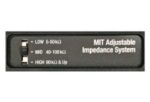MIT Cables Technologies
MIT is an Audio Interface, which represents an Engineered Solution, used to Interface an Audio System together. These engineered solutions ensure Maximum Articulation, while Minimizing System Distortions.

Multipole Technology™
“Every audio cable, no matter the manufacturer, has a point along the audio bandwidth where the relationship of capacitance and inductance is most efficient at storing energy. We refer to this point of efficiency as an Articulation Pole. Electrically, articulation is a measure of the efficiency of a cable or network to store energy and transport power. This transportable power is used to move the speaker and produce sound. The more efficiently the energy is stored and then transported, the more natural the sound will be.
A cable that has its Articulation Pole tuned to a high frequency is described by audiophiles as “bright” or “fast.” Conversely, a cable that has its Articulation Pole tuned to a lower frequency would be described by audiophiles as “muddy” or “veiled.” MIT Cables’ interfaces are engineered to have multiple Articulation Poles.
Theoretically, if you could use three different cables at the same time, each with a different Articulation Pole, to interconnect two audio components together, you would have an interface with three Articulation Poles; one for the highs, one for the mids, and one for the lows. Together, they would work to transport the audio signal from component to component more efficiently, and with more articulation. This is what MIT Cables accomplishes with its patented technology, to a much greater extent, within each engineered interface. We call this Multipole Technology. The benefit is more lifelike vocals and instruments, mid and high frequencies become less bright or tiring, voices are clear and understandable, and bass frequencies become tight and deep.

2C3D HologramTM
2C3D by MIT® (2C3D is an acronym that stands for “Two-Channel, Three-Dimension”) is a technology pioneered by Bruce Brisson, founder of MIT Cables. 2C3DTM technology was engineered to create a believable three-dimensional soundstage from a two channel system. This technology offers the optimal balance between detail, imaging and a lifelike soundstage that has a true sense of “depth.” 2C3DTM makes it easy to identify each of the individual instruments and voices within a soundstage that retains height, width and depth, at any volume level.
Imagine yourself in the back row of an auditorium listening to your favorite piece of live music. 2C3DTM technology effectively picks you up and places you right in the exact sweet spot of the auditorium. You are then able to perfectly experience the directionality and dimensionality of the performance. This is the 2C3DTM experience.

SIT™ - Stable Image Technology™
Stable Image Technology means that the image will; both stay focused and stay in place within the soundstage, as well as not grow or shrink relative to other images, at any frequency or any power level.
Stable Image Technology provides a focused image in size and location across the entire dynamic range. From the softest whisper to the most demanding crescendo.

JFA™ - Jitter Free Analog™
Music signals continually move from positive voltage to negative voltage, over a given period of time. The point, at which they make that transition, is what is called the Zero Baseline.
Jitter Free Analog means; any jitter that is generated at the zero base line, as is found with ‘Just Cable’, is eliminated with JFA technology.
The big benefit is; JFA reduces all forms of extraneous noise produced by ‘Just Cable’ as the music signal periodically crosses the zero crossing point.In other words, reducing jitter helps to reduce noise artifacts generated by a simple cable.
The results are; a blacker background is generated on which to paint the sonic picture. Proper timber is maintained, including all of the harmonic structure held within the complex tones envelope.
Also, reducing the extraneous noise, allows for a higher contrast between the various layers of textures, which now become much

JFA II™ - Jitter Free Analog Second Generation™
JFA II is an update designed to control a commonly misunderstood effect occurring in most audio systems. This effect is the result of an electrical event that causes the fundamental, or its harmonics, to quickly jitter or “shuttle” slightly within the sonic envelope. It’s perceived by the mind’s eye as a blur, or halo effect emanating from the sonic image. This phenomenon is damaging to articulation, timbre and the complex textures of music. With JFA II, low level detail is enhanced and spatial cues are believable.
With the exquisite capabilities of the newest generation of dynamic transducers and newly emerging tweeter technologies, the positive effect of JFA II is particularly relevant. Above all, JFAII preserves an accurate, stable music signal. This technology benefits the system not only in the tonal realm, but also by allowing the system to create a stable image within and beyond the edges of the speakers and room.
JFA II circuitry is partially engaged without the 2C3DTM knob turned on. When you engage the 2C3DTM Knob, you fully engage JFA II. When you turn the 2C3DTM Knob to on; it engages new circuitry that we call JFA II. This circuitry works from approximately 80 Hz. to 800 Hz.

EM™ - Energy Management™

HD - High Definition
While MIT’s “standard definition” is based on the patented “Multipole Technology” offering greatly improved transport of the audible music signals far better “Than Just Cable”, MIT developed a “High Definition” option attained by engaging F.A.T – Fractional Articulation Technology. F.A.T. retrieves information existing within the octaves of the musical signal.

SHD™ - Super High Definition™

F.A.T.™ - Fractional Articulation Technology™ and SD, HD, and SHD Switching
Depending on the series of speaker interfaces, with the simple flip of a switch, you can move from “standard definition” to “high definition” to “super high definition” mode by activating Fractional Articulation Technology (F.A.T.).
First introduced in our Maximum Articulation products in 2010,F.A.T. enables the interfaces to retrieve additional information that resides within each octave of the musical signal, forming individual images with crisp detail and without artificial hardness. Smooth and liquid from top to bottom, F.A.T. precisely extracts information lost by JUST cables, rendering incredible detail and solid image placement with more lifelike transients than ever thought possible. The result: improved timbre, texture and unparalleled detail, while preserving all of the delicate spatial information associated with 2C3DTM playback.
F.A.T. and the value of “2 Cents”
The philosopher Pythagoras is credited with discovering that musical harmony, or consonance comes when the ratio of musical frequencies consist of simple numbers. The story tells of the philosopher talking as he passed a blacksmith shop. While hearing the familiar sounds of ringing hammers he discovered that it was the weights of the hammers themselves that were responsible for the relative tones he heard. He was able to determine that a hammer weighing half as much as another sounded twice as high. This is an octave (2:1). A pair with a weight ratio of 3:2 (a fifth apart) sounded beautiful as well. He discovered that simple ratios made the most pleasing (consonant) sounds.
The more simple the ratio between the harmonic and the fundamental, the more consonant the harmonic is.
Music intervals and cents– A cent is a unit of measure used for musical intervals. In the western scale, an octave contains 1200 cents. Because each octave has twelve notes, the interval or space between each note is 100 cents*. Cents are often used to measure extremely fine intervals. It is commonly accepted that a person can detect a five to six cent interval. For example, if middle C on a piano lost its tuning to a degree of six cents, the human ear will detect that the key is out of tune, whether it is sharp (up) or flat (down). Most audiophiles are able to discern a two cent interval or less. This may be due to practice, hours spent listening to music, or it may be simply related to an individual’s “innate ability”. This accounts for the ability of one person to detect the tiniest nuance in music while another person may not. Because of the audiophile’s acute ability to discern these minute differences between tones, extreme care must be given in the design and construction of an audio interface to ensure that the consonant intervals and all harmonics being optimized are done so within an exacting tolerance. This technology is only provided by MIT.

Impedance Switching™ - What does the Impedance Switching Do?
Impedance is the measure of the opposition that an electrical circuit presents to the passage of a current when a voltage is applied. In quantitative terms, it is the complex ratio of the voltage to the current in an alternating current (AC) circuit. It includes both the circuit’s resistive, as well as reactive components.
It is well understood that a cable influences the performance of the individual components it is interfacing into a system. Volume output and high frequency loss are the first things that audiophiles notice when impedances are not optimized. MIT has also written papers regarding how the articulation response of the system is also influenced by impedance variations (Please refer to MIT White Paper 102— The effects of Audio Cable as Related to Articulation of Speech and Music – available here as a PDF).
MIT’s Selectable Impedance Networks allow the user to carefully match the cable’s impedance to the input and output impedances for your hardware. This allows the user to optimize sonic performance, improving tonality, micro dynamics, image size and specificity, as well as soundstage proportions. This same technology is also available in our MA Series Phono interconnects.

A.A.R.M.™ - The Adjustable Articulation Response Module
The Oracle MA-X articulation selector allows the listener to “fine tune” this interface for optimal balance between transients, detail, imaging and musicality. All with the simple rotation of the MIT patent-pending Articulation Selector integrated into every Oracle MA-X interconnect.
The illustration below is an artist’s rendering of the Oracle MA-X articulation response for each setting of the Articulation Selector switch. The base line is the 50% line. The plus values raise the articulation above the 50% line, which will enhance system transients, detail, imaging and musicality. The negative values below the 50% line will tend to have the opposite effects on a system.
It is purely subjective when deciding where the selector switch should be set—experiment a bit and set the selector switch where you feel your system performance is best, and enjoy the music!

MIT Z Filterpole Tchnology™
The Z Series of power products from MIT uses patented parallel “AC Filterpoles”™ a tuned LCR technology.
MIT Filterpole technology eliminates reflections by efficiently absorbing all forms of AC noise from the mains, and then converting it into harmless thermal heat.The result?
Once the Z circuitry is working to clean, condition and protect your AV system, you will instantly enjoy “blacker” blacks, better color saturation, and increased shadow detail; movie sound tracks will deliver dialog, Foley sounds and background music with theater-like quality. Because your audio system now has a lowered noise floor, you will have pinpoint audio image placement within a lifelike soundstage, all with clear and authoritative bass.
Power Factor Correction: Stops Energy Waste
MIT’s Z Stabilizer circuitry also provides “PFC” (Power Factor Correction), by controlling the phase angle of the inbound AC sine wave for maximum efficiency.
With PFC you will:
Use less energy for the same work
Prolong the life span of most electronic components
Never limit your current flow
Clean power from MIT provides:
Greater Clarity
Increased Contrast
Enhanced Dynamics
What are MIT Filterpoles™?
Poles of Attenuation (Referenced in The Impedance Domain) A properly built AC filter will not only attenuate unwanted noise on the AC power line, but it will also optimize the power factor.
Power Factor is a (dimensionless) number between 0 and 1. When power factor is equal to 0, the energy flow is entirely reactive, and stored energy in the load returns to the source on each cycle. When the power factor is 1, all the energy supplied by the source is consumed by the load and nothing is reflected back to the source. MIT was awarded a patent on this technology regarding audio in July 13, 1993: number 5,227,962.
The best way to attenuate unwanted noise is to create a very low impedance (a zero of impedance across the load which acts as an attenuation pole to the noise) surrounding the frequency (or frequencies) of the undesirable noise. In the case of audio, that would be at any frequency other than the power line frequency. This is best accomplished by placing a tuned circuit in parallel, around the load. MIT was awarded this patent on November 9, 1993: number 5,260,862.
